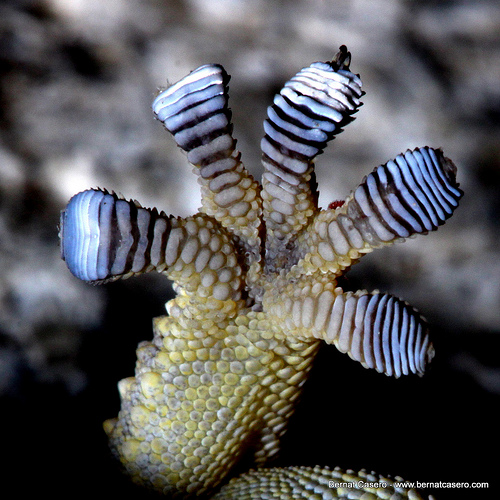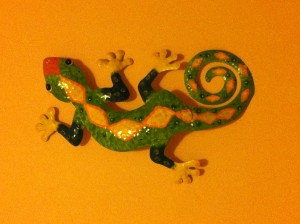We are amassing quite a collection of geckos around our house these days. Not the organic variety of course, although that would really please the kids! No, our collection consists of ornaments, wall hangings, trinkets and even jewellery. It all started ten years ago when on honeymoon in Barcelona … the little guys were everywhere and we were drawn to them with fascination – especially their ability to scale any surfaces they encountered (even glass). So the collection started from there, anytime we come across a quirky gecko decoration or ornament we like, we purchase and add it to the collection!
Ten years on and our fascination has grown along with our collection. I was delighted to show my children a recent photo from National Geographic of a gecko. Of course that lead to the children asking questions, that lead to questions, that led to the ultimate… “How do they walk up walls?” After answering their questions I decided this might be a good topic to start my 2013 blog with. So…how do these amazing little creatures manage their “spiderman-like” feats? It truly is a marvel of nature but before I delve into that, I want to tell you a few other quirky facts about these lovely little creatures.
Geckos are a type of lizard. They are found on all continents except Antartica. They come in many shapes and sizes and are in fact the most species rich order among lizards. They are also among the most colourful lizards in the world.
Most species of geckos can actually sever part of their tail, usually to escape the hold of a predatory or threat. The released tail segment can keep wriggling as a distraction while the gecko escapes. PRETTY COOL DON’T YOU THINK? This process of severing the tail is called caudal autotomy!

Another very interesting fact about geckos is that nearly all species of geckos have no eye lids and can therefore not blink. Instead, they use their long tongues to clean any dust from their eyes.
Already you can begin to see how fascinating these creatures are, and that is before we have even looked at their ability to apparently defy gravity! DID YOU KNOW THAT A GECKO CAN SUPPORT ITS ENTIRE BODY WEIGHT ON ONE TOE?
So here is the science bit behind HOW THEY DO IT…the toes of a gecko are covered in hundreds of small ridges called lamellae. Each ridge is covered in millions of hairs called setae. Setae are much thinner that human hair (up to 30 times thinner). Each seta then splits at the top into tiny strands called spatulae – there can be up to 1000 spatulae on one seta (if you think you have problems with split ends, pity the poor gecko!). So you can begin to imagine how tiny these spatulae are, in fact, they are so tiny that they can bond with the molecules of the surface they are touching. This bonding is referred to as van der Waals interaction! The great thing about it is that it is what is called dry adhesion – it doesn’t require any sticky compounds or leave any messy residue.

This gives us an idea of how the gecko sticks to the surface, but HOW DOES IT UNSTICK? The adhesion (sticking) process is said to be one-directional…imagine sticking a piece of sticky tape to a surface and then taking hold of one edge and peeling it back to remove it… the gecko does something similar. Geckos toes bend in the opposite direction to humans so they can “peel” their toes off the surface from the tip backwards. Add to this the fact that geckos have rotating ankles and you start to understand how they can move in any direction.
As you can imagine this ability has captured the interest of Scientist for a long time. Imagine if we could copy this adhesion from the gecko… what could we do with the technology??? Robots that can scale any surface would be great in extreme or rescue situations, right? Or how about a suit we could wear to allow us to climb like a gecko? Did you know that geckos can climb in a vacuum? So now we can start thinking about using this technology in space! Or how about using the technology in bandages – inspired by the observation that geckos can climb in wet conditions… a bandage that stays on when wet.
Maybe YOU can think of another novel way to use gecko technology? If you have any ideas I’d love to hear them!
More on geckos…
Nat Geo Kids Creature Facts – Geckos
The dance of the disembodied gecko tail
Geckos evolved sticky feet many times
